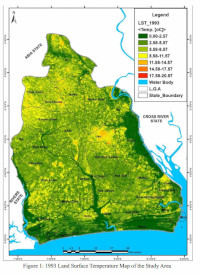Evidence of Climate Change: Understanding the Land Surface Temperature of Akwa Ibom State
Main Article Content
Abstract
The quagmire of climate change is a global issue especially with rapid urban growth and development experienced in major cities over the past decades. This study was necessary to prove the evidence of the existence of climate change in the state within the last three decades, through understanding the land surface temperature of Akwa Ibom State. This study investigated Land Surface Temperature (LST) changes in Akwa Ibom State as an evidence of justifying climate change pandemic in the state. Landsat multispectral imageries covering the study area were acquired for three periods 1993-2003, 2003-2013 and 2013-2023. LST was derived using a single channel algorithm applied on the imagery thermal bands. Change statistics were computed to evaluate the transition dynamics of LST across the three decade sunder consideration. Result indicated that as of 1993, the surface temperature increased by between 1993-2003. Increase in surface temperature was also observed within the study area in 2013 compared to 2003. In 2023, the surface temperature keeps increasing above 400Cwithits minimum composition of 12.040C. This shows a steady increase in the land surface temperature of the area over decades. This increasing temperature status can be attributed to the reduction in vegetation in the progressive years due to high level of unguided anthropogenic activities and urbanization. This justifies the existence of climate change in Akwa Ibom State within the last three decades. It was thus recommended that government, NGOs and private individual should intensify efforts by taking deliberate measures like creating climate change awareness and policies on mitigation aimed at moderating urban growth while ensuring the conservation of urban greens spaces in the state and adaptation strategies in coping with the already changing climate.
Downloads
Article Details
Section

This work is licensed under a Creative Commons Attribution-NonCommercial 4.0 International License.
Share
References
1. Datta, D., Prasad, M., & Mandla, V. R. (2017). Study of various factors influence on land surface temperature in urban environment. Journal of Urban and Environmental Engineering, 11(1), 58–62.
2. IPCC. (2021). Climate Change 2021: The Physical Science Basis. Contribution of Working Group I to the Sixth Assessment Report of the Intergovernmental Panel on Climate Change.
3. Mehmood, R., & Butt, M. A. (2019). Appraisal of urban heat island detection of Peshawar using land surface temperature and its impacts on environment. Journal of the Indian Society of Remote Sensing, 47, 1091–1096.
4. Nichol, J. E., Wong, M. S., & Lee, K. H. (2009). Urban Heat Island research in Asia: A review. Science of The Total Environment, 407(7), 2227–2238.
5. Obiefuna, J. N., Nwilo, P. C., Okoli, C. J., Emmanuel, E. I., & Daramola, O. E. (2018). Dynamics of land surface temperature in response to land surface cover changes in Lagos Metropolis. Nigerian Journal of Environmental Sciences and Technology, 2(2), 148–159.
6. Oguz, H. (2013). LST Calculator: A program for retrieving land surface temperature from Landsat TM/ETM+ imagery. Environmental Engineering and Management Journal, 12(3), 549–555.
7. Oke, T. R. (1982). The energetic basis of the urban heat island. Quarterly Journal of the Royal Meteorological Society, 108(455), 1–24.
8. Sekertekin, A., & Bonafoni, S. (2020). Land surface temperature retrieval from Landsat 5, 7, and 8 over rural areas: Assessment of different retrieval algorithms and emissivity models and toolbox implementation. Remote Sensing, 12, 294.
9. Sobrino, J., Jimenez-Munoz, L., & Paolini, L. (2004). Land surface temperature retrieval from LANDSAT TM 5. Remote Sensing of Environment, 90(4), 434–440.


